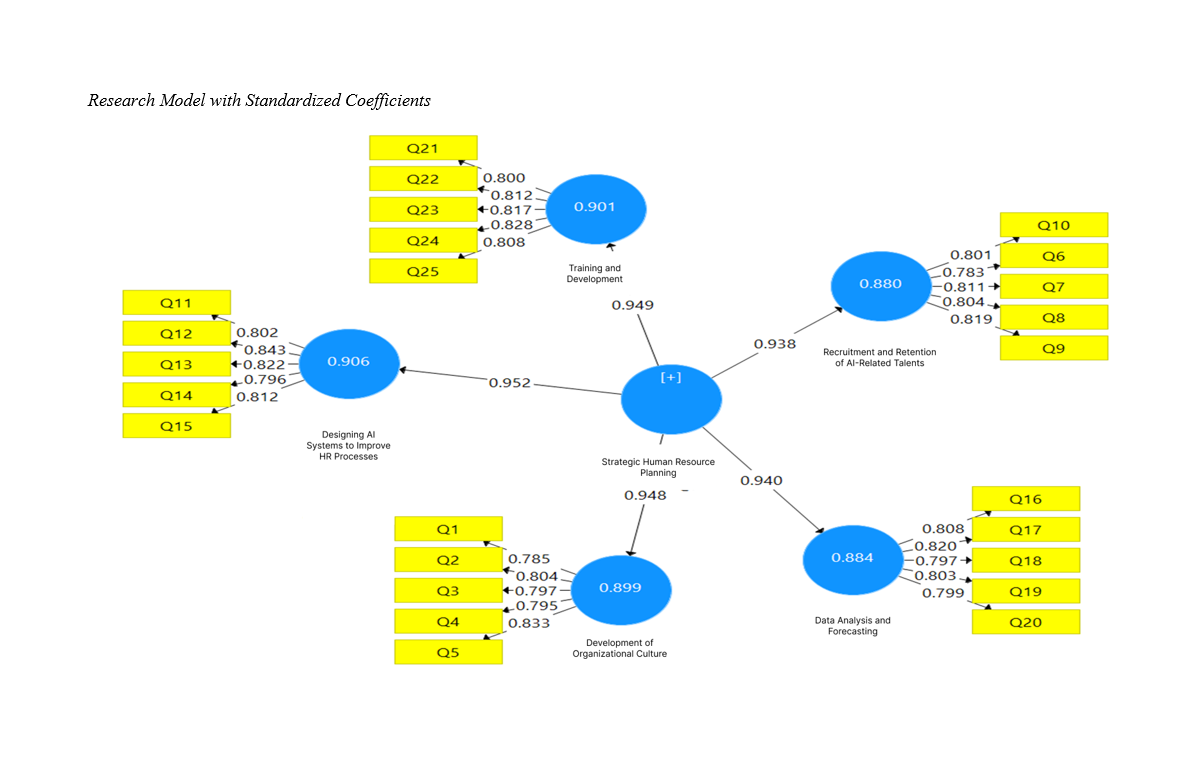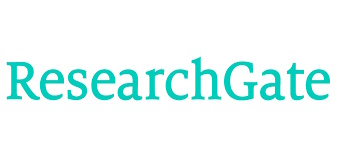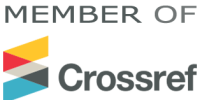Assessment and Evaluation of a Strategic Human Resource Planning Model Based on Artificial Intelligence Development in Advertising Companies in Karbala
Keywords:
Strategic planning, human resources, artificial intelligence development, advertising companiesAbstract
The objective of the present study is to design a strategic human resource planning model based on the development of artificial intelligence (Case Study: Advertising Companies in Karbala). From a purpose perspective, this study is applied, and in terms of method, it is descriptive-survey. The research follows a mixed-methods approach combining qualitative and quantitative methods. The qualitative population includes advertising companies in Karbala, while the qualitative sample comprises academic experts in the fields of human resources, computer science and artificial intelligence, information systems, and managers of advertising firms in Iraq, selected for qualitative analysis and interviews. The participants in this phase were chosen purposively based on the principle of theoretical saturation. The sampling method employed was snowball sampling. In the quantitative phase, the statistical population consists of employees of advertising companies in Iraq who were asked to complete a questionnaire developed based on factors derived from the qualitative analysis. The quantitative sample size was determined using Cochran’s formula. Given the unlimited population size, the sample size was calculated as 384 respondents, selected randomly. In the qualitative part, data analysis was conducted using thematic analysis, while in the quantitative part, structural equation modeling was used via SmartPLS software. The qualitative results revealed five dimensions for the model: development of organizational culture, recruitment and retention of artificial intelligence-related talents, design of AI systems to enhance HR processes, data analysis and forecasting, and training and development. The model's validity was examined using structural equations. Based on the calculations, the overall model fit index (GOF) was found to be 0.66, indicating a strong model fit. A significant relationship value of 223.512 was obtained between strategic human resource planning and training and development. The second-order factor loading was calculated as 0.949. For the relationship between strategic human resource planning and data analysis and forecasting, the significance value was 169.426, confirming a meaningful relationship. The second-order factor loading was 0.940. For the relationship between strategic human resource planning and organizational culture development, a significance value of 210.672 was obtained, confirming the relationship. The second-order factor loading was 0.948. Regarding the relationship between strategic human resource planning and the recruitment and retention of AI-related talents, a significance value of 167.958 was observed, indicating a significant relationship. The second-order factor loading was calculated as 0.938.
References
AlDhaheri, H., Hilmi, M. F., Abudaqa, A., Alzahmi, R. A., & Ahmed, G. (2023). The relationship between HRM practices, innovation, and employee productivity in UAE public sector: A structural equation modelling approach. Int. J. Process Manag. Benchmarking, 13, 157-176. https://doi.org/10.1504/IJPMB.2023.128471
Ali, O., & Kallach, L. (2024). Artificial Intelligence Enabled Human Resources Recruitment Functionalities: A Scoping Review. Procedia Computer Science, 232, 3268-3277. https://doi.org/10.1016/j.procs.2024.02.142
Arumugam, T., Arun, R., Natarajan, S., Thoti, K. K., Shanthi, P., & Kommuri, U. K. (2024). Unlocking the Power of Artificial Intelligence and Machine Learning in Transforming Marketing as We Know It. IGI Global. https://doi.org/10.4018/979-8-3693-0049-7.ch005
Barrett, B. (2024). Artificial Intelligence (Ai) Skills Sets For Today's Human Resource Management Professionals: Recognizing The Need For Additional Technology Training And Development. IATED. https://doi.org/10.21125/inted.2024.1335
Cai, F., Zhang, J., & Zhang, L. (2024). The Impact of Artificial Intelligence Replacing Humans in Making Human Resource Management Decisions on Fairness: A Case of Resume Screening. Sustainability, 16, 3840. https://doi.org/10.3390/su16093840
Gandrita, D. M., Gandrita, A., Rosado, D. P., & Carmo, M. d. (2023). Environmental Sustainability for Strategic Planning Effectiveness and Organizational Improvement. Sustainability, 15, 6774. https://doi.org/10.3390/su15086774
Khan, W. A., Minghai, Y., Akbar, A., Khan, A. K., & Moldez, R. G. (2024). Impact Of Human Resources Planning On The Actualization Of Organizational Goal. International Journal of Contemporary Issues in Social, 526-532.
Lishner, I., & Shtub, A. (2023). Enhancing Strategic Planning of Projects: Selecting the Right Product Development Methodology. Information, 14, 632. https://doi.org/10.3390/info14120632
Noor, S. (2018). Manajemen Sumber Daya Manusia. Yogyakarta: Graha IlmuER -.
Paroli, P. (2024). Implementation of strategic planning as an organizational human resources management process. Jurnal Ekonomi, 13(01), 1834-1841.
Qaderi, M., Rahimi, R., & Nejad Haj Ali, I. (2023). Pathology of the Strategic Human Resource Planning System in Education and Providing an Optimal Model. Management, 4(3), 85-96.
Rismayadi, B. (2024). Opportunities and Challenges for Using Artificial Intelligence Technology in Human Resource Management. Journal of Data Science, 2(01), 32-40. https://doi.org/10.58471/jds.v2i01.4273
Rusilowati, U., Narimawati, U., Wijayanti, Y. R., Rahardja, U., & Al-Kamari, O. A. (2024). Optimizing Human Resource Planning through Advanced Management Information Systems: A Technological Approach. Aptisi Transactions on Technopreneurship (ATT), 6(1), 72-83. https://doi.org/10.34306/att.v6i1.390
Salvador-Gómez, A., Bou-Llusar, J. C., & Beltrán-Martín, I. (2022). A multi-actor perspective on the effectiveness of human resource management implementation: An empirical analysis based on the ability-motivation-opportunity framework. Int. J. Hum. Resour. Manag., 1-39.
Subyantoro, A., & Suwarto, F. X. (2020). Manajemen Sumber Daya Manusia Strategi. Penerbit Andi.
Sultan, M. (2022). Kolaborasi Stakeholder's Dalam Penyelenggaraan Corporate. Jurnal Widyaiswara Indonesia, 3(2), 81-94. https://doi.org/10.56259/jwi.v3i2.135

Downloads
Published
Submitted
Revised
Accepted
Issue
Section
License
Copyright (c) 2024 Ghanim Salman Salih Alzahloli (Author); Sayed Hamidreza Mirtavousi; Alaulddin Buraa Jawad Alaameri, Siamak Korang Beheshti (Author)

This work is licensed under a Creative Commons Attribution-NonCommercial 4.0 International License.









